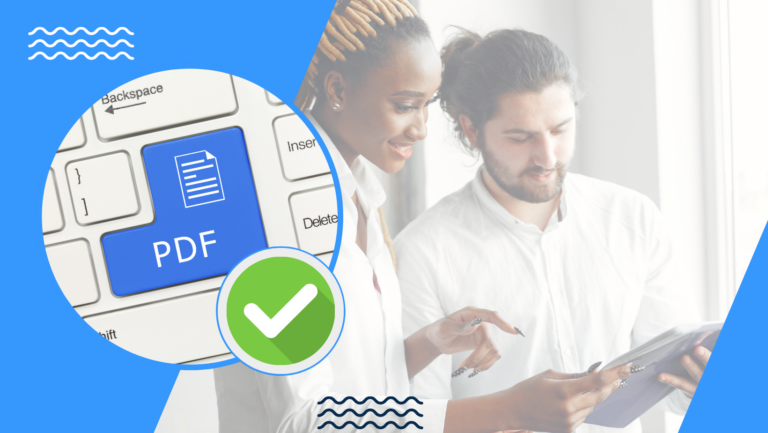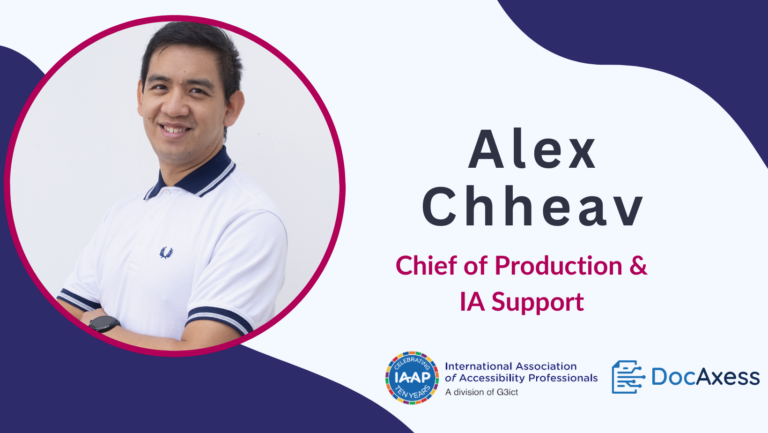We design PDFs every day. This convenient format has become the most widely used medium in digital communication. Why and how to make these documents accessible to everyone? Discover the top 5 reasons to make your PDFs accessible and incorporate PDF accessibility into your strategy.
However, unknowingly, most editors create barriers to access content.
One of the challenges posed by this image format is being able to render it in an intelligible and audible manner content that has often been designed solely for visual reading.
You’re preparing your communication budget, and you’re hesitating:
- Interactive and responsive interface?
- Customized website?
Do you want to invest in the Annual Report, which is the showcase of the brand, but what about the other PDF documents?
Below is the list of advantages of transforming a simple PDF into an accessible PDF.
Definition of an Accessible PDF
As a reminder, accessibility according to the W3C and international standards WCAG 2.1, involves providing access to web content and interfaces for everyone.
Today, PDFs are often sent, received, and read through our computers. Printing is becoming less common, although it remains the most widely used format in business.
A PDF is a document that many organizations use to exchange information. In terms of communication, this PDF is the result of work by the design agency that developed an entire graphic concept using InDesign/QuarkXPress.
Unfortunately, it is not read by screen readers or text-to-speech synthesizers.
This means that a blind or visually impaired person equipped with such tools for navigation will not be able to access the content.
Without processing, the screen reader cannot decipher the content of the PDF.
Adobe and PDF Accessibility
The creator of the PDF format, Adobe, has developed tools to make this format accessible.
How to create an accessible PDF?
The creation of an accessible PDF document at the source is much faster than retroactive tagging in Acrobat.
This approach avoids most of the manipulations that were previously performed in Adobe Acrobat Pro. It allows for significant time savings, which can, in some cases, amount to up to 80% compared to retroactive tagging in Acrobat.
Completely redoing a PDF document from Acrobat Pro can take a considerable amount of time. Using source creation is the best method to facilitate the standardization of accessible PDF documents.
The integration into the production chain must take into account that the information in a document is accessible to all, and best practices must be followed in:
- The drafting of content,
- The graphic design of the document,
- The construction of the document in Adobe InDesign or Word,
- The finalization of the document with Adobe Acrobat Pro.
What are the criteria that must be absolutely adhered to?
- Use accessibility features in editing software (alternative text, heading levels, tables, etc.) upstream of the PDF.
- Force the reading order of the document for the XML coding of the PDF,
- Integrate the XML tags for the content of the PDF.
On a typical page, we will integrate:
- the H1 tag for the title,
- the H2 tag for the subtitle,
- the H3 tag for the third-level title,
- the <p> tag for the texts,
- the alt tag for images and tables,
- the <figure> tag for graphics, … .
By using XML tag integration to hierarchize information, the screen reader reads the document in a structured and understandable manner.
The points not to forget for a good audio reading of the PDF file:
- The reading direction,
- The language,
- The display of the page in “single page” mode,
- The clarity of the pages.
The appearance of the document will not have changed even if, in the background, a whole process has been carried out based on the ISO 14289-1 accessibility standards.
This work will allow the document to be rendered by the screen reader, similar to HTML language.

5 Reasons to Make Your PDF Accessible
1. Increase the audience for your PDFs
By transitioning from a simple PDF to an accessible PDF, you enable your colleagues, shareholders, investors, and other stakeholders with disabilities to access information like any other user.
Your company automatically gains additional readers. This approach also builds trust and goodwill for your organization because these individuals feel acknowledged and included.
Digital accessibility is a fundamental right; every user has the right to access public information.
Result: You significantly optimize the upfront investment made in creating this document by expanding your target audience.
2. A comprehensive Corporate Social Responsibility initiative
This action is part of a comprehensive inclusive approach in the Corporate Social Responsibility (CSR) strategy of your organization. The increase in your audience is based on your societal commitment, which is manifested through actions with the general public and your stakeholders.
It’s no longer just a mere ‘label.’ These social and ethical issues become a priority through these actions. The company itself becomes a bearer and actor of its message.
Especially since working on the accessibility of your documents reinforces the quality logic stemming from the AFNOR 26 000 standard, overseeing this social and environmental initiative of the company.
3. Achieve Better Natural Search Engine Optimization (SEO)
To ensure that your PDF document naturally ranks in Google’s indexing, you need to focus on working on these 3 aspects:
- The accessibility of your publication,
- SEO content with keywords,
- Clear navigation.
A boon for our inclusive and e-accessible strategy!
Google likes it when everything is structured and specified. The more comprehensive and relevant the content, the better your natural search engine optimization will be.
4. Focus on Compliance with Disability Legislation
Recently, Europe and France have advanced the debate around digital accessibility and disability through the enactment of various laws.
The French law on the Digital Republic of 2016 aligns with the European Directive on Digital Accessibility.
It continues the work that had already been initiated with the release of the French law of 2005 for the equality of rights and opportunities, participation, and citizenship of people with disabilities.
This 2016 law expands the legal obligation for web accessibility to public entities and affiliated organizations, as well as to businesses with a turnover equal to or greater than 250,000 euros.
Article 44 of the Professional Future law transposes the European Directive by increasing penalties from 5,000 euros to 25,000 euros and introducing the concept of disproportionate burden.
5. Enhance Your Non-Financial Rating
Publicly traded companies are assessed by non-financial rating agencies. They have the responsibility to deliver an evaluation of the quality of Environmental, Social, and Governance (ESG) commitments.
Their financial rating method is based on various criteria. One of the fundamentals in the analysis is precisely communication to stakeholders, which must be transparent and accessible.
More and more institutional funds favor investments in companies with the best ESG scoring in their category.
Switch to Accessible PDF
Be smart, PDF is the most exchanged document among your collaborators.
For your future financial statements, Reference Document, Letter to Shareholders, Shareholder Handbook, switch to accessible PDF.
Update: Explore new technologies, particularly Artificial Intelligence in the service of disability.













